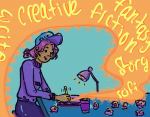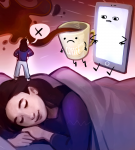A world in which we feel energized, have high GPAs and walk around with smiling faces may seem farfetched – but it’s actually quite attainable when we cultivate healthy sleeping habits.
An all-nighter is not an unfamiliar feat amongst college goers who have twice as many sleep issues as the overall population. However, the evidence of harmful effects over any perceived benefits of sleep deprivation should encourage students of all ages to seek simple yet effective ways to improve their sleep cycle, and therefore their mood, health and performance. This simple goal of improving sleep for the new year can help you begin to reach other goals, from making healthier food choices to focusing better in school.
A University of Minnesota study found that students who pulled all-nighters tended to have lower GPAs, but with increased and regular sleep time, students’ grades consequently tended to improve. The importance of sleep not only lies in academic performance, but in the overall energy, positivity and focus that follows a good night’s sleep.
In an interview for UCLA Magazine, neurosurgeon Itzhak Fried points to the fact that when individuals are deprived of sleep, both their motor abilities and their perception of the world slows down.
In 2017, Fried conducted a study observing the effects of sleep deprivation on individual brain cells details the mental lapses one experiences after an all-nighter – a mental lapse quite similar to driving a car or taking a test drunk.
Paul Macey, a neuroscientist and associate professor in the school of nursing at UCLA, said researchers have been seeing links between poor sleep habits, and issues from resultant depression and anxiety to more latent effects like diabetes or Alzheimer’s.
A board member of the mental health awareness club Active Minds, Elena Sternlicht said she feels social consequences from a lack of sleep. During times of low sleep, she recognizes her inclination to judge people, snap at others and feel more overwhelmed by general negativity.
“I feel fatigued in the afternoon without a regular sleep schedule, crash really hard and waste time trying to fuel my brain with food or distractions to stay awake,” said the second-year psychology student.
These consequences are effects of disrupted rapid eye movement sleep, the deep, dreamy state in which short-term memories become long-term memories. So not only are the memories of these four years at school at risk of being partially erased, but the memory of lectures of the day are also at risk, affecting academic life.
First-year public affairs student Amy Stanfield recalls the downward spiral stemming from decreased sleep quality and how it affected her work throughout her first quarter at UCLA.
“In the beginning of the quarter, I was overwhelmed with the social opportunities causing me to stay up late and … disregard my homework completely,” Stanfield said. “The amount of coffee I drank wired me well into the night, and didn’t make me necessarily productive, but instead made me super distracted.”
Luckily for Stanfield, Sternlicht and many other students, there are many ways to improve sleep length, quality and regularity, which are the key to maintaining a sense of calmness and regularity in daily routines.
There are tried and true ways to enhance your sleep, many of which are as easy as making your bed in the morning to create a comfortable, anxiety-reducing space for later, and allowing that space to be a sleep-inducing tech-free zone.
Given the melatonin-damaging nature of the blue light we interact with on our numerous screens, making conscious efforts to reduce light by wearing blue-light blocking glasses or an eye mask proves essential to a good night’s rest.
“Our brain associates bright light with daytime,” Macey said. “So, making the effort to plug your phone in somewhere before bed and giving yourself a period between phone use and rest to simply brush your teeth or read a book will remind your brain that it’s night, not daytime.”
Alongside the multitude of light sources, there are sound sources that can further disrupt a night routine on campus. Second-year international development studies student Maddie Cashel said the times that she doesn’t sleep well generally stem from having caffeine in the afternoon, but also from the noise of the piano right outside her window, which students often play despite quiet hours. To combat the loud melodies outside her dorm room at night, Cashel invested in a set of earplugs, which gave way to a much deeper, distraction-free sleep.
Additionally, caffeine acts as a promising stimulant to stay alert, but in practice, harms sleep patterns and ability to focus. Despite coffee’s omnipresence on campus, try and avoid caffeine at least six hours before bedtime in order to prevent it from impairing the quality of your sleep by blocking the “sleepiness” receptor in the brain. Instead of caffeine, you can incorporate naturally occurring melatonin-rich foods like cherries and sleep-inducing teas like valerian root or chamomile to ease you into sleep.
Except for the presleep cup of tea, eating and exercising should be completed by about 8 p.m. To avoid excess stimulation, eat a light meal two to three hours prior to sleep, exercise in the morning, and go for a light walk in the evening to allow time for the body to settle before bed.
“People underestimate the impact going for a run, a hike or a drive through nature can do not only for the body, but for sleep,” Macey said. “Finding these natural rhythms can provide a much deeper level of happiness and sleep promotion than the modest impact that six months of antidepressants and sleep aids prescribed to young students can.”
With changes like these in your daily behavior, incorporating a nightly, soothing routine becomes essential in cultivating healthier sleep. At night, lavender essential oil can work to calm nerves, muscles and slow the heart rate to reduce stress. By going to bed at around the same time each night and embracing practices like aromatherapy, meditation, journaling, or stretching, you allow yourself a quicker fall-asleep time and a deeper sleep, and at the same time, incorporate self-reflective techniques that boost your mood.
Macey said our bodies have a natural way of catching up and adapting to our sleep, but only when we let ourselves recover instead of continuing the cycle of poor sleep. So, allow your body a quick nap or early night in, instead of an all-nighter, to maximize your time for socializing, studying and bouncing back from prior sleepless nights.
“You have people pick what works for them,” Macey said. “Just being aware of your experiences and paying attention to what does and doesn’t work for your sleep is key to maintaining healthy sleep practices.”






